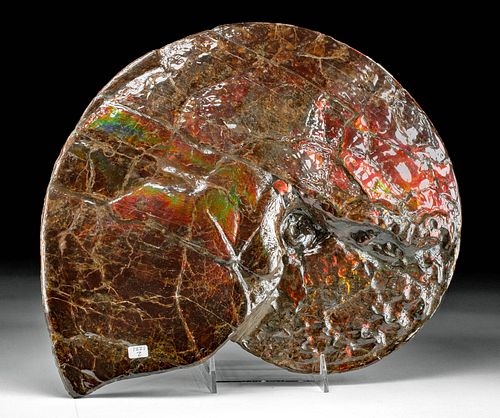Large Ammonite Fossil Fiery Iridescent Ammolite
About Seller
686 S Taylor Ave, Ste 106
Louisville, CO 80027
United States
Selling antiquities, ancient and ethnographic art online since 1993, Artemis Gallery specializes in Classical Antiquities (Egyptian, Greek, Roman, Near Eastern), Asian, Pre-Columbian, African / Tribal / Oceanographic art. Our extensive inventory includes pottery, stone, metal, wood, glass and textil...Read more
Two ways to bid:
- Leave a max absentee bid and the platform will bid on your behalf up to your maximum bid during the live auction.
- Bid live during the auction and your bids will be submitted real-time to the auctioneer.
Bid Increments
| Price | Bid Increment |
|---|---|
| $0 | $25 |
| $300 | $50 |
| $1,000 | $100 |
| $2,000 | $250 |
| $5,000 | $500 |
| $10,000 | $1,000 |
| $20,000 | $2,500 |
| $50,000 | $5,000 |
| $100,000 | $10,000 |
| $200,000 | $20,000 |
About Auction
Nov 10, 2022
Museum-worthy examples of classical antiquities (Egyptian, Greek, Roman, Near Eastern), Viking, Far East / Asian, Pre-Columbian, African / Tribal, Oceanic, Native American, Spanish Colonial, Nautical, Fossils, Ancient Jewelry, Fine / Visual Arts, so much more! Artemis Gallery info@artemisgallery.com
- Lot Description
North America, Canada, Alberta, Bearpaw formation, late Cretaceous, ca. 71 million years ago. This fossilized ammonite shell has formed a fiery iridescence across the surface known as ammolite, which is much like opal in coloration, however ammolite is one of the few "biogenic" or organic gemstones as it only develops from fossilized ammonite shells! The color play is hard to capture in photos - the umber hue shifts to ruby, deep crimson, and some yellow and green throughout. Ammolite is exceedingly rare, indeed it is only found on ammonites in the Bear Paw formation! This fossil was prepared by the company Canada Fossils Ltd, the sister company to Korite, the largest commercial producer of natural ammolite gemstones and jewelry. Together, they provide ammonites and other amazing finds to important institutions, including an ammonite on display in the American Museum of Natural History in New York! Size: 15.75" Diameter x 2.3" W (40 cm x 5.8 cm); 8.5" H (21.6 cm) on included custom stand.
Ammolite is a rare, iridescent, gem-quality material cut from the fossilized shells of extinct sea creatures known as ammonites. Found only in the Bearpaw Formation in Alberta, Canada - along the eastern slopes of the Rocky Mountains - this organic gemstone has a dazzling range of colors and patterns and is highly desired for freeform natural cabochons and assembled jewelry pieces.
According to the International Gem Society (IGS) statement on the difference between Ammolite and Ammonite: "You may find the terms ammolite and ammonite sometimes used interchangeably. However, ammonite, strictly speaking, refers to the fossil shells of ammonites, whether gem-quality or not. Ammolite refers to the gem-quality material made from fossils of particular species of ammonites." Also, according to IGS, "Ammonites were marine mollusks that became extinct around 65 million years ago. There were many species of ammonites, and their fossils have been found across the globe. The fossils of Placenticeras meeki, Placenticeras intercalare, and Baculites compressus can yield gem-quality ammolite. To date, this material has been found only in Alberta, Canada."
This ammonite species, known as Plancenticeras meeki, was anything but meek - this was a swift predator that swam after prey, and did not passively float in the current. Their genus name is in honor of Fielding Meek (1817 to 1876), a pioneer in American paleontology. They could reach a staggering 1 meter (3.3 feet) in diameter - imagine a shelled creature of that size with tentacles outstretched swimming by!
Provenance: Private Berthoud, Colorado, USA collection
All items legal to buy/sell under U.S. Statute covering cultural patrimony Code 2600, CHAPTER 14, and are guaranteed to be as described or your money back.
A Certificate of Authenticity will accompany all winning bids.
We ship worldwide and handle all shipping in-house for your convenience.
#174791Professionally prepared. Striations and stable fissures throughout as expected with age and fossilization process. Surface is coated in thick, clear protective fixative. AA grade coloration with 3 colors visible colors. Old inventory number on chamber opening.Condition
- Shipping Info
-
Artemis Gallery will no longer be able to offer in-house shipping for most international orders, as well as all oversized orders, including most paintings. These items are clearly marked in the listing as “3rd Party Shipping Required” in the listing. We have a list of recommended third party shippers to assist you in shipping to and from, and would be happy to assist you in working with them. We require a written authorization from the client to release property to any third party. You may fax a Shipping Release Form to 303-828-3235 or email your authorization to kristen@artemisgallery.com. Please note the all property must be removed from our premises within seven (7) business days following the last day of the auction.
-
- Buyer's Premium



 EUR
EUR CAD
CAD AUD
AUD GBP
GBP MXN
MXN HKD
HKD CNY
CNY MYR
MYR SEK
SEK SGD
SGD CHF
CHF THB
THB















